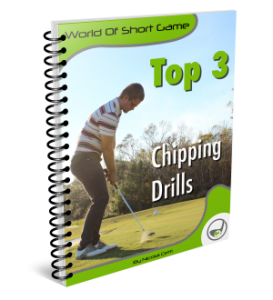- +4527976587
- mail@worldofshortgame.com

Chipping Distance Control Tips: Mastering Roll After the Landing Spot

Chipping Distance Control Tips: Mastering Roll After the Landing Spot
Chipping Distance Control Tips: Mastering Roll After the Landing Spot
Controlling the distance of a chip shot involves more than just knowing how far the ball will carry. Once the ball lands, understanding how much it will roll is equally crucial. In this guide, we’ll cover key chipping distance control tipsthat focus on how to manage the ball’s roll after it lands. By mastering these tips, you’ll be able to control your chipping distance more effectively and improve your short game.
Understanding the Roll: Key Factors
There are three main factors that influence how much the ball rolls after landing:
- Landing Angle: The angle at which the ball touches down.
- Surface: The type of surface the ball lands on.
- Spin: The amount of backspin on the ball.
These three factors work together to determine how much or how little the ball will roll after it lands. Let’s break them down in more detail.
Looking to improve your short game? I'm currently offering online lessons through the Skillest app with a 50% discount on your first lesson for all readers of the World of Short Game blog. Simply use the promo code "WOSG50percent" when booking your first session to get started at a discounted rate. Let’s work on your game together! ⛳️
Factor 1: Landing Angle
The landing angle is one of the biggest contributors to how much the ball will roll. A steeper landing angle (where the ball falls almost straight down) will result in less roll, as the ball loses momentum upon impact. A shallower landing angle (when the ball lands flatter) will cause the ball to roll more because it retains more energy after hitting the ground.
- Steeper Landing Angle: Results in less roll, useful for getting the ball to stop quickly near the hole.
- Flatter Landing Angle: Creates more roll, ideal for when you need the ball to travel a longer distance on the green after landing.
How to Control Landing Angle:
The height of the shot largely determines the landing angle. The higher the shot, the steeper the landing angle, and the less the ball will roll. Here’s how you can influence the landing angle:
- Club Selection: Using a higher lofted club like a 60-degree wedge creates a higher shot with a steeper landing angle.
- Shaft Lean: When you reduce shaft lean (less forward press), the ball launches higher, resulting in a steeper angle.
- Clubface Angle: Opening the clubface also produces a higher shot, adding loft and steepening the landing angle.
Factor 2: The Landing Surface
Where the ball lands can drastically affect how it behaves after the initial impact. Different surfaces—whether it’s the fairway, fringe, or rough—provide varying levels of resistance that impact how the ball rolls.
- Greens: When the ball lands on the green, it tends to roll smoother and more predictably.
- Fringe or Rough: Landing on the fringe or rough slows the ball down significantly due to the thicker grass, which reduces roll.
- Fairway: The ball can roll more freely on shorter grass, allowing for greater roll distance after the initial landing.
How to Choose the Correct Surface:
When selecting a landing spot, always consider the surface. If you want more roll, aim for a landing spot on the green or fairway. If you need the ball to stop quickly, landing on thicker grass like the fringe or rough can help slow it down.
Factor 3: Spin Rate
The amount of backspin you put on the ball can also affect how much it rolls after landing. More spin makes the ball stop quickly or even spin backward, while less spin allows it to roll farther.
How to Control Spin:
For most amateur golfers, controlling spin is quite difficult, but advanced players can manipulate spin by:
- Clubface Control: Opening the clubface adds more backspin, especially on softer shots.
- Clean Contact: The cleaner the contact between the clubface and the ball, the more spin you can generate. This requires precise ball-striking and a clean lie.
- Greenside Conditions: Wet or soft greens tend to increase spin, while hard, dry greens decrease spin.
However, for most golfers, controlling spin should not be the main priority. Instead, focusing on landing angle and surface selection will be more manageable and consistent.
Prioritizing Landing Angle and Surface
While spin is important, it is less reliable for most amateur players. Instead, focus on controlling the landing angle and selecting the right landing surface. These two factors are easier to manage and can have a bigger impact on how the ball rolls after landing.
- For Beginners: Focus primarily on controlling the landing angle. Using a consistent swing length and lofted club can help you get a feel for the landing spot and roll.
- For Advanced Players: You can begin incorporating spin control to fine-tune your distance control on delicate shots where precision is key.
Practical Drills for Distance Control
Here are a few practical drills to help you practice controlling the roll after your ball lands:
Landing Spot Drill
- Place a towel or another target on the green where you want the ball to land.
- Practice hitting chips that land on the towel and see how much the ball rolls afterward with different clubs.
Surface Variation Drill
- Practice landing the ball on different surfaces (fringe, rough, fairway) and observe how it rolls. This will help you understand how different surfaces affect the roll.
Controlled Height Drill
- Experiment with changing the landing angle by adjusting the height of your shots. Use different lofted clubs and see how the height influences the ball’s roll distance.
Final Takeaways: Mastering Chipping Distance Control
Controlling the roll of a chip shot is key to consistent short game success. By mastering the landing angle, considering the surface, and eventually adding in spin control, you can dial in your chipping distance control. Focus on these elements during practice, and you’ll find yourself getting closer to the pin and lowering your scores.
With consistent practice and by following these chipping distance control tips, you’ll build confidence in your short game and make more putts, saving strokes around the green. Happy chipping!
Looking to improve your short game? I'm currently offering online lessons through the Skillest app with a 50% discount on your first lesson for all readers of the World of Short Game blog. Simply use the promo code "WOSG50percent" when booking your first session to get started at a discounted rate. Let’s work on your game together! ⛳️
You must be logged in to post a comment.



